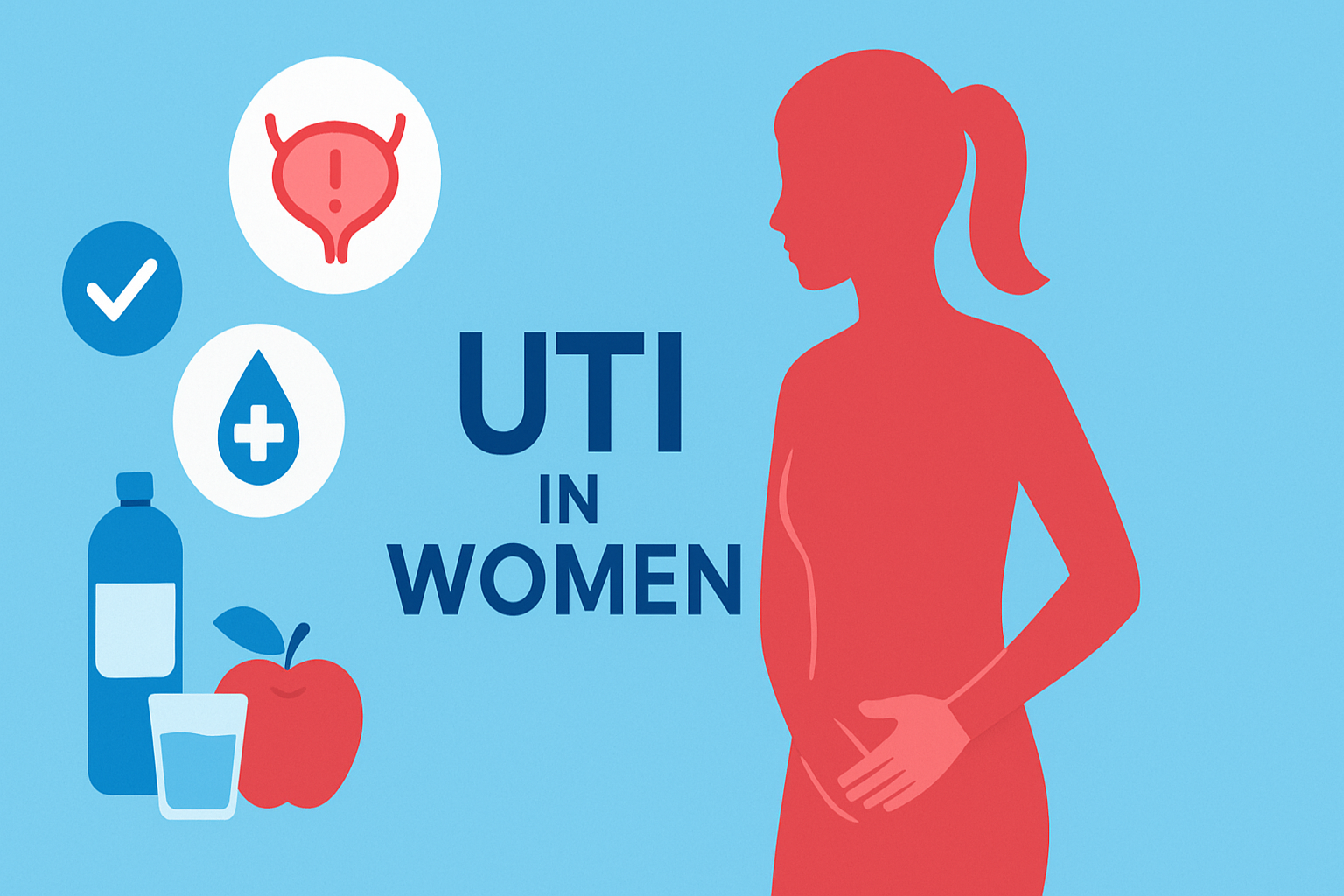Introduction: Understanding UTI in Women
UTI in women is a very common yet often overlooked health issue that affects the urinary system — including the kidneys, ureters, bladder, and urethra. These infections are primarily caused by harmful bacteria, most commonly E. coli, that enter the urinary tract and multiply. Due to their shorter urethra and anatomical structure, women are naturally more prone to developing UTIs than men.
The symptoms of UTI in women can vary, but they usually include a burning sensation while urinating, frequent or urgent urges to urinate, cloudy or foul-smelling urine, and a feeling of pressure or discomfort in the pelvic region. In more severe cases, fever or back pain may occur if the infection spreads to the kidneys.
Understanding the underlying triggers — such as poor hygiene, dehydration, hormonal imbalance, or sexual activity — is crucial for prevention. Recurrent urinary tract infections in women can sometimes be associated with hormonal or reproductive health concerns. Conditions like PCOD and PCOS can indirectly influence UTI risk by altering hormone levels and immune responses, emphasizing the importance of maintaining hormonal balance along with good urinary hygiene.
By staying aware of the causes, symptoms, and preventive strategies, women can manage UTIs effectively and protect their long-term urinary and reproductive health.
Common Triggers of UTI in Women
Several lifestyle habits, health conditions, and biological changes can increase susceptibility to UTI in women. Understanding these triggers is important for prevention and early management.
1. Improper Hygiene Practices
Poor hygiene is a leading cause of UTI in women. Wiping from back to front can transfer bacteria to the urethra, while scented soaps or douches may disrupt natural vaginal flora. Always wipe front to back and use mild, unscented products. Hormonal health factors are also important, as discussed in PCOS Explained: Warning Signs and Management.
2. Holding Urine for Too Long
Delaying urination allows bacteria to multiply in the bladder, increasing the risk of urinary tract infections in women. Emptying the bladder every 3–4 hours helps flush bacteria naturally.
3. Certain Birth Control Methods
Diaphragms or spermicides can disrupt the natural bacterial balance in the genital tract, raising the risk of UTI in women. Women with recurrent infections should discuss alternative contraceptives with their healthcare provider.
4. Tight or Non-Breathable Clothing
Synthetic or tight-fitting clothes trap heat and moisture, creating a breeding ground for bacteria. Loose-fitting cotton garments reduce the risk of urinary tract infections in women.
5. Inadequate Hydration
Low water intake concentrates urine, irritates the bladder, and promotes bacterial growth. Drinking 2–3 liters of water daily helps prevent UTI in women.
6. Sexual Activity
Intercourse can push bacteria toward the urethra, increasing susceptibility to UTI in women. Urinating before and after sexual activity lowers infection risk.
7. Menopause and Hormonal Changes
Reduced estrogen levels after menopause thin vaginal walls and reduce protective bacteria, making women more prone to UTI in women. Related hormonal and reproductive health issues are explained in What is Cancer? Causes, Symptoms and Treatments.
8. Diabetes and Weakened Immunity
High blood sugar and a weakened immune system create ideal conditions for bacterial growth, increasing the chance of recurrent UTI in women. Managing diabetes, maintaining a balanced diet, and following good hygiene are key preventive strategies.
Effective Prevention Strategies for Women
Preventing UTI in women involves simple daily habits, lifestyle adjustments, and medical guidance when necessary. Implementing these strategies can significantly reduce the risk of recurrent infections.
1. Stay Hydrated
Drinking enough water is one of the easiest ways to prevent UTI in women. Adequate hydration helps flush out bacteria from the urinary tract, reducing infection risk. Women should aim for 2–4 liters daily unless otherwise advised by their doctor.
2. Maintain Proper Hygiene
Good hygiene is essential for lowering the chances of urinary tract infections in women. Always wipe from front to back and avoid harsh soaps, scented products, or douches that can disturb the natural balance of bacteria in the genital area.
3. Urinate After Intercourse
Sexual activity can introduce bacteria into the urethra, increasing the likelihood of UTI in women. Urinating immediately after intercourse helps flush out bacteria and prevents infections.
4. Wear Breathable Clothing
Tight or synthetic clothing can trap moisture, promoting bacterial growth. Choosing cotton underwear and loose-fitting garments helps maintain airflow and reduces the risk of urinary tract infections in women.
5. Cranberry Supplements
Cranberry extract has been shown to prevent bacteria from adhering to the walls of the urinary tract, which can lower the chance of UTI in women. Supplements can be considered as part of a preventive routine, but consult a healthcare provider first.
6. Manage Blood Sugar Levels
Women with diabetes are more susceptible to infections. Keeping blood sugar levels under control reduces bacterial growth and prevents UTI in women. Regular monitoring, a balanced diet, and proper medication adherence are essential.
7. Hormone Therapy if Recommended
Postmenopausal women may experience changes in vaginal flora due to reduced estrogen, increasing the risk of UTI in women. Localized estrogen therapy, when advised by a healthcare provider, can help maintain vaginal health and lower infection risk.
Symptoms Indicating Immediate Medical Attention
Recognizing the warning signs of UTI in women is crucial for timely medical intervention. While mild urinary discomfort can sometimes resolve on its own, certain symptoms indicate a more serious infection that requires prompt attention.
1. Burning Sensation or Pain While Urinating
A persistent burning sensation or pain during urination is one of the earliest and most common indicators of UTI in women. Ignoring this symptom can allow the infection to progress to the bladder or kidneys. For a comprehensive overview of urinary tract infections, you can refer to the CDC: Urinary Tract Infection Overview.
2. Frequent Urges to Urinate
Feeling the need to urinate more often than usual, even with little urine output, is another hallmark of a urinary tract infection. This symptom reflects bladder irritation and bacterial activity, which should not be overlooked in UTI in women.
3. Cloudy or Foul-Smelling Urine
Urine that appears cloudy, dark, or has a strong odor often signals bacterial growth in the urinary tract. These changes are typical warning signs of UTI in women and require medical evaluation.
4. Lower Abdominal or Back Pain
Discomfort or pain in the lower abdomen or back can indicate that the infection has reached the bladder or kidneys. Persistent pain is a clear sign that medical attention is needed.
5. Fever or Chills
A high temperature, chills, or general malaise often suggests that the infection is severe and may be spreading beyond the bladder. Such systemic symptoms are a red flag for UTI in women. For details on causes and preventive strategies, see Mayo Clinic: UTI Causes & Prevention.
If you notice any of these symptoms, consult a healthcare professional promptly. Understanding how these signs can be linked to broader reproductive or hormonal health can also be helpful, as discussed in PCOS Explained: Warning Signs and Management
Frequently Asked Questions (FAQ)
Q1. What causes UTI in women?
UTI in women is primarily caused by bacteria, usually E. coli, entering the urinary tract. Factors like poor hygiene, holding urine too long, certain contraceptives, or hormonal changes can increase the risk.
Q2. What are the common symptoms of UTI in women?
Typical symptoms include burning during urination, frequent urges to urinate, cloudy or foul-smelling urine, lower abdominal or back pain, and sometimes fever. Early recognition is important to prevent complications.
Q3. How can UTI in women be prevented?
Prevention strategies include staying hydrated, maintaining proper hygiene, urinating after intercourse, wearing breathable clothing, and managing blood sugar levels. Cranberry supplements and hormone therapy (if recommended) may also help.
Q4. When should a woman seek medical attention for a UTI?
Medical advice should be sought immediately if there is severe burning, persistent urge to urinate, cloudy or foul-smelling urine, lower abdominal or back pain, or fever. Prompt treatment reduces the risk of kidney involvement.
Q5. Can hormonal changes affect the risk of UTI in women?
Yes, hormonal fluctuations, especially after menopause or in conditions like PCOS, can alter vaginal flora and make women more susceptible to UTI in women. Consulting a healthcare provider for guidance is recommended.
Conclusion: Maintaining Long-Term Urinary Health
UTI in women is a common condition that affects millions globally, but it can often be prevented with awareness and simple lifestyle practices. Staying hydrated helps flush bacteria from the urinary tract, while maintaining proper hygiene, wearing breathable clothing, and urinating after sexual activity can significantly reduce the risk of infection.
For example, a woman who drinks adequate water, wears cotton underwear, and urinates regularly may experience far fewer urinary infections compared to someone who delays urination or wears tight synthetic clothing. Being aware of underlying health factors like hormonal imbalances, menopause, diabetes, or conditions such as PCOS allows women to take proactive measures to maintain urinary health.
Additionally, consulting trusted medical resources can help reinforce preventive habits and proper care. Reliable guidance from organizations like the CDC: Urinary Tract Infection Overview and Mayo Clinic: UTI Causes & Prevention provides detailed insights on causes, prevention, and management of UTI in women, including when to seek medical attention.
Regular check-ups, timely medical consultation, and adopting healthy daily habits are key to preventing recurrent infections and ensuring long-term urinary health. By integrating these measures, women can significantly reduce their risk of UTIs and improve overall quality of life.
Disclaimer: This article is for educational purposes only and is not a substitute for professional medical advice. Always consult a qualified healthcare provider regarding any concerns about UTI in women or related health issues.

